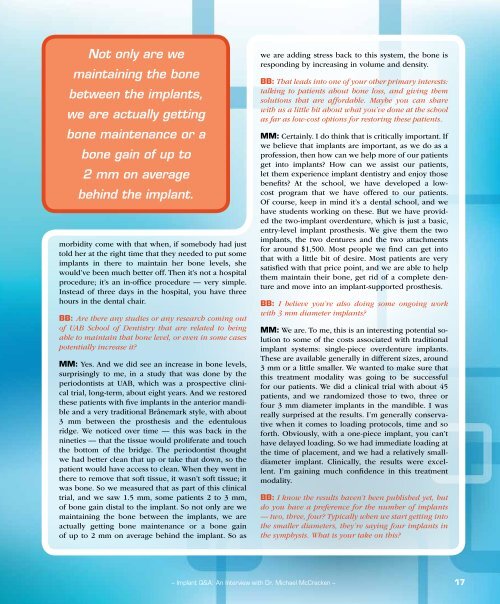PDF Download - Glidewell Dental Labs
PDF Download - Glidewell Dental Labs
PDF Download - Glidewell Dental Labs
Create successful ePaper yourself
Turn your PDF publications into a flip-book with our unique Google optimized e-Paper software.
Not only are we<br />
maintaining the bone<br />
between the implants,<br />
we are actually getting<br />
bone maintenance or a<br />
bone gain of up to<br />
2 mm on average<br />
behind the implant.<br />
morbidity come with that when, if somebody had just<br />
told her at the right time that they needed to put some<br />
implants in there to maintain her bone levels, she<br />
would’ve been much better off. Then it’s not a hospital<br />
procedure; it’s an in-office procedure — very simple.<br />
Instead of three days in the hospital, you have three<br />
hours in the dental chair.<br />
BB: Are there any studies or any research coming out<br />
of UAB School of Dentistry that are related to being<br />
able to maintain that bone level, or even in some cases<br />
potentially increase it?<br />
MM: Yes. And we did see an increase in bone levels,<br />
surprisingly to me, in a study that was done by the<br />
periodontists at UAB, which was a prospective clinical<br />
trial, long-term, about eight years. And we restored<br />
these patients with five implants in the anterior mandible<br />
and a very traditional Brånemark style, with about<br />
3 mm between the prosthesis and the edentulous<br />
ridge. We noticed over time — this was back in the<br />
nineties — that the tissue would proliferate and touch<br />
the bottom of the bridge. The periodontist thought<br />
we had better clean that up or take that down, so the<br />
patient would have access to clean. When they went in<br />
there to remove that soft tissue, it wasn’t soft tissue; it<br />
was bone. So we measured that as part of this clinical<br />
trial, and we saw 1.5 mm, some patients 2 to 3 mm,<br />
of bone gain distal to the implant. So not only are we<br />
maintaining the bone between the implants, we are<br />
actually getting bone maintenance or a bone gain<br />
of up to 2 mm on average behind the implant. So as<br />
we are adding stress back to this system, the bone is<br />
responding by increasing in volume and density.<br />
BB: That leads into one of your other primary interests:<br />
talking to patients about bone loss, and giving them<br />
solutions that are affordable. Maybe you can share<br />
with us a little bit about what you’ve done at the school<br />
as far as low-cost options for restoring these patients.<br />
MM: Certainly. I do think that is critically important. If<br />
we believe that implants are important, as we do as a<br />
profession, then how can we help more of our patients<br />
get into implants? How can we assist our patients,<br />
let them experience implant dentistry and enjoy those<br />
benefits? At the school, we have developed a lowcost<br />
program that we have offered to our patients.<br />
Of course, keep in mind it’s a dental school, and we<br />
have students working on these. But we have provided<br />
the two-implant overdenture, which is just a basic,<br />
entry-level implant prosthesis. We give them the two<br />
implants, the two dentures and the two attachments<br />
for around $1,500. Most people we find can get into<br />
that with a little bit of desire. Most patients are very<br />
satisfied with that price point, and we are able to help<br />
them maintain their bone, get rid of a complete denture<br />
and move into an implant-supported prosthesis.<br />
BB: I believe you’re also doing some ongoing work<br />
with 3 mm diameter implants?<br />
MM: We are. To me, this is an interesting potential solution<br />
to some of the costs associated with traditional<br />
implant systems: single-piece overdenture implants.<br />
These are available generally in different sizes, around<br />
3 mm or a little smaller. We wanted to make sure that<br />
this treatment modality was going to be successful<br />
for our patients. We did a clinical trial with about 45<br />
patients, and we randomized those to two, three or<br />
four 3 mm diameter implants in the mandible. I was<br />
really surprised at the results. I’m generally conservative<br />
when it comes to loading protocols, time and so<br />
forth. Obviously, with a one-piece implant, you can’t<br />
have delayed loading. So we had immediate loading at<br />
the time of placement, and we had a relatively smalldiameter<br />
implant. Clinically, the results were excellent.<br />
I’m gaining much confidence in this treatment<br />
modality.<br />
BB: I know the results haven’t been published yet, but<br />
do you have a preference for the number of implants<br />
— two, three, four? Typically when we start getting into<br />
the smaller diameters, they’re saying four implants in<br />
the symphysis. What is your take on this?<br />
– Implant Q&A: An Interview with Dr. Michael McCracken – 17

















